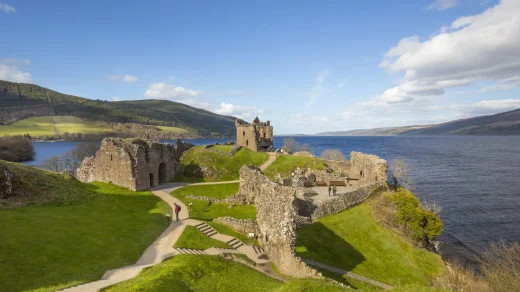Skara Brae – Neolithic

One of the most remarkable discoveries in modern archaeology: in 1850 a violent storm ravaged the Bay of Skaill in the Orkney Isles to the north-east of mainland Scotland, revealing the Neolithic village of Skara Brae buried beneath the sand dunes. It is the best preserved Neolithic village in northern Europe and it offers us a unique window into the lives of the farmers who lived there between 3,100 and 2,450 BC.
Skara Brae’s remarkable survival through the ages is thanks to the design of the original builders who buried the stone-slab walls up to roof level in clay soil and waste material in order to provide insulation and protection from the elements.
Such a tightly knit and communal village life was unusual in these early farming communities, individual farmsteads being preferred, but Skara Brae seems to have been a very close community with little room for non-conformists. Every house has the same layout for roughly a family-sized living space.
 |
Upon entry to any of the houses, one has to crouch through a small doorway which would have been blocked by a slab of stone and possibly barred as well. This shows that security was important to the dwellers, but that privacy for the family unit was also very important. The layout of Skara Brae, whilst being very much geared towards a community settlement, makes this type of privacy possible.
Inside, each house has a large floor space with a central hearth where no doubt the fire was always burning. Since the main source of timber on Orkney was driftwood from the forests of North America, most of the furniture was made of stone and has survived well leaving many clues to these people’s lifestyles. Opposite the doors, large, stone dressers are still intact, where objects of importance could be displayed, but secret spaces have also been found under the stone dresser for those objects the families were less keen to display. On either side of the living space were stone beds, which would have been filled with bracken and heather, and covered with animal skins.
The villagers were farmers, raising large cattle and sheep and growing a little barley. Their diet contained many foods which would be regarded as luxuries today. Venison from deer imported to Orkney. Meat and eggs from seabirds like the Great Auk. Oysters, crabs, cockles and mussels, as well as giant cod and saithe from the sea. Strangely, no fishing equipment was discovered when the village was excavated, but water-tight tanks in the floor of each house were probably designed to hold limpets for fish bait.
Just outside the complex of houses, a workshop stands on its own where chert – a local flint substitute – was made into stone tools. Also, volcanic pumice, washed up on Orkney’s beaches from Iceland, was used to shape bone tools. In good years, they lived well with some leisure time; and they made works of art like bone necklaces and the mysterious stone balls carved from hard volcanic rock.
Very few other signs of settlement from the late Neolithic Age remain to us, probably due to their timber construction, but the inhabitants of Orkney, being dependent on stone for construction, have left us a valuable door into their world.




That’s really cool. An entire village made of stone! And the high level of community must’ve felt very safe, special.
yes David, they must have felt safe until someone or another tribe tried to take over them. thank you.
Valid point!
Thanks again.